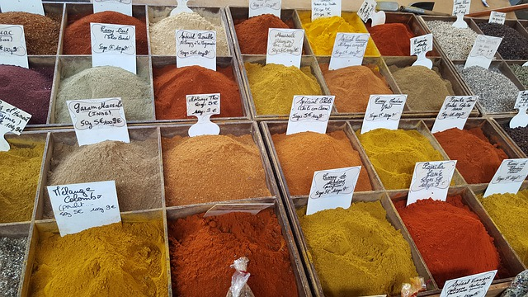Oriental spice: fruity-mild to fiery-hot
The colourful and aromatic spices of the Orient invite you to a festival of the senses. Already in the 7th century seafarers brought them to us in the Occident. They experienced a “high” period in the monastery kitchens and naturopathy of the Middle Ages. Many of them are well known to us, some are still to be discovered. They turn even simple lentils, beans or chickpeas into delicious tasting meals.
Pepper heats and is good against cold feet and hands. Pepper contains piperine, a special active ingredient that reduces fever and helps with general colds.
Many chillies are rich in vitamin C and have an antibacterial effect. Their sharpness sometimes triggers a sensation similar to pain, which releases the body’s own substances, which brings relaxation and comforting warmth.
Clove relaxes and helps against headaches and toothache. Chewing on a carnation removes even stubborn bad breath.
Pimento, also known as pimento, tastes like a mixture of clove, pepper, cinnamon and nutmeg, i.e. fiery, sweet at the same time.
Saint Hildegard of Bingen already used nutmeg against depressive moods. She recommended nutmeg spiced sweet spelt rolls to her melancholy patients.
Mace (Macis), the red seed coat of the nutmeg, tastes milder and spicier and is also more valuable than this because only 1 kg of maces falls on 400 kg nutmeg.
Cinnamon warms from the inside and is supposed to create mental balance. Its blood sugar regulating effect, with which cinnamon has a preventive effect against adult-onset diabetes, has been researched.
In the Middle Ages, they considered coriander an aphrodisiac. The high content of essential oils helps with disorders in the stomach and intestines and has a calming effect on the nerves.
Cardamom is like coriander. The best way to preserve the essential oils and taste is to remove the seeds from the encapsulated capsules just before use and crush them in a mortar.
Turmeric is as yellow as saffron, the most expensive of all spices. Turmeric tastes of ginger and has a stimulating effect on digestion and the heart and circulation. In contrast, saffron, like a nutmeg, supports the good mood.
Ginger tastes fruity and spicy and is considered the “divine fire” among the spices of the Orient. It is supposed to bring inner imbalance into balance and also has a warming effect.
Cumin has nothing in common with the caraway known to us. It is the “leading spice” of oriental cuisine, supports digestive activities and stimulates the appetite.
Star anise gives dishes an aniseed-like note. It helps against flatulence, eases cough irritation and is expectorant.
Author: Brigitte Neumann
imprint data privacy images by www.pixabay.com

